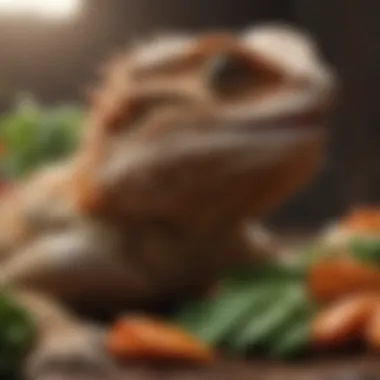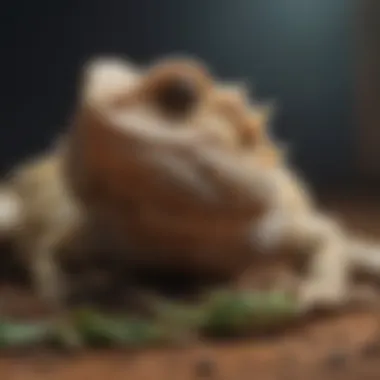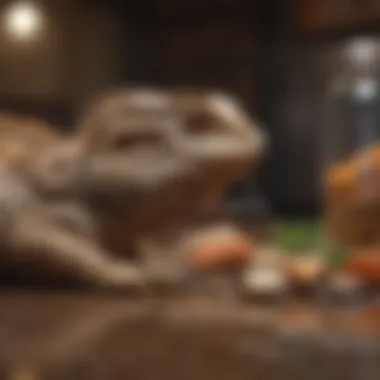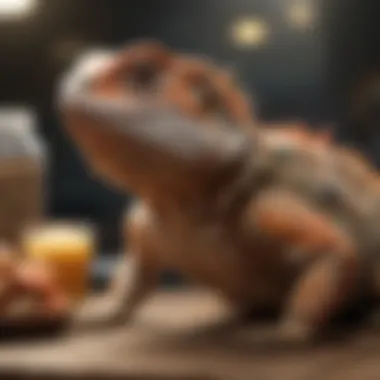Essential Feeding Guidelines for Your Bearded Dragon


Intro
Feeding a bearded dragon entails more than simply giving them food. It involves a comprehensive understanding of their dietary needs at various developmental stages. Knowing what to feed these reptiles, as well as how frequently to feed them, lays the foundation for maintaining their overall health. Understanding how their conditioning might change according to life stages can significantly influence their growth and well-being.
This narrative aims to serve as a detailed overview of the feeding guidelines necessary for bearded dragon owners. We delve into key aspects related to diet, from essential nutrients to special feeding programs based on age. By grasping this cardinal knowledge, owners can thoroughly support their pets' health throughout their life. It is crucial not only for the happiness of your pet but also may enhance the interaction you both enjoy.
Care Tips
Caring for your bearded dragon involves several key elements that contribute to their well-being. Nutrition, environment, and routine management all play critical roles.
Daily Care Routines
Establishing a daily routine enhances the health of your bearded dragon. Feeding times should be consistent and tailored to their age, size, and dietary needs. Adult dragons usually require feeding two to three times a week, while juveniles need feeding every day to support their growth.
Additionally, providing water is essential. Fresh, clean water should be specifically available every day. Observing your dragon's drinking patterns can provide information on hydration levels.
Cage Setup and Maintenance
The creation of a suitable habitat is vital. The enclosure should be spacious enough to allow movement and exploration. Bearded dragons need a temperature gradient within their tank. The basking area should reach temperatures between 100°F to 110°F, while a cooler side must remain around 75°F to 85°F.
Regular cleaning is also part of maintaining a healthy environment. Waste needs to be removed daily and complete cleaning once a week can prevent parasite infestations and unpleasant odors.
Hygiene and Cleaning Practices
Hygiene impacts bearded dragons just as it impacts humans. Regular bathing and cleaning their habitat enhances health. Consider a shallow bath for hydration as well. Some owners bathe their dragons once a week or every two weeks, ensuring water is lukewarm.
Another key point in hygiene involves ensuring external objects in the cage, such as rocks or wood, are free from contamination. Periodic disinfecting of the terrarium ensures bacteria levels remain low.
Seasonal Care Adjustments
Adjustments in care might be warranted with changing seasons. In cooler months, minimizing exposure to cold drafts aids in maintaining body temperature. Conversely, during hotter months, increasing bathing frequency might prevent overheating. Factors like these can impact not only comfort but also nutritional absorption.
Behavioral Insights
Behavioral understanding plays a role in healthy interaction and feeding setups. Examining your bearded dragon's body language enables effective care and feeding adjustments. It fosters a better bond between pet and owner.
Understanding Bearded Dragon Body Language
Bearded dragons express themselves through various body language cues. Puffing up their beard signifies defense, while arm waving indicates submission. Observing these signals aids in deciphering your pet's needs.
Common Behavioral Issues and Solutions
Rutinely monitoring behavior for signs of stress or discomfort is vital. A frequently stressed dragon may refuse food. A consultation with a vet should be arranged if abnormal behaviors persist.
Positive Reinforcement Techniques
Rewarding your bearded dragon post feeding with occasional treats can enhance training. Positive experiences can develop trust and connection, which encourages comfortable feeding experiences.
Social Interaction Needs
Bearded dragons vary in their desire for interaction. Some may prefer isolation, while others enjoy limited social bonding. Recognizing these characteristics can improve feeding mechanics and lifestyle practices.
Nutrition Guides
Proper feeding practices encompass an understanding of nutritional needs and risks. A well-structured diet directly impacts vitality.
Essential Diet Components
A balanced diet includes greens, fruits, and insects. Leafy greens such as collard and mustard greens comprise the bulk of their routine intake. Fruits provide essential vitamins but should only appear as occasional treats.
Safe and Toxic Foods
Many items can be safely consumed, yet others pose health risks. For example, avocados are toxic. Always determine what is good for them specifically. Familiarize yourself with these resources: Wikipedia, Britannica.
Supplements and Treats
Supplements may play a role in their health regimen. Calcium and vitamin D3 supplements can ensure needed nutrients lacking in their feeding practices. Occasional insects like crickets or mealworms may serve as treats to support their diet.
Feeding Strategies for Different Life Stages
Juvenile bearded dragons have diverse needs compared to adults. A young dragon may require a higher frequency of feeding! Furthermore, their portions must contain higher protein concentrations compared to older dragons.


Wellness and Health
Bearded dragon health is tied closely to their nutritional intake. Awareness of health check-ups and symptoms of illness is necessary to nurture longevity.
Routine Health Checkups
Regular vet visits are strongly encouraged. A veterinarian should perform thorough checkups every six months or annually.
Identifying Symptoms of Illness
Learning to determine when something is wrong encapsulates good care. Attention should be given to changes in appetite or energy levels, as these can show discomfort.
Preventative Care and Vaccinations
Routine preventative medications contribute to a healthy adult dragon. Innate immunity builds through good diet and external care. Proper vaccinations can lead to healthier lives.
Mental and Emotional Well-being
Understanding emotional significance cannot be overlooked as well. Like comfort items or familiar routines in their habitat act as a stress reducer, helping immeasurably with health and happiness.
Enriching Activities
Providing enrichment in the form of toys and various activities can improve overall health and satisfaction in life. Time outside the habitat can lead to positive mental stimulation.
Toys and Playtime Ideas
Functional toys can stimulate mind and behavior. Items like climbing structures or hiding spots for insects can bring joy to your bearded dragon.
Training and Tricks
Potential for learning exists here. Simple commands combined with food rewards may gradually train them. Done intelligently, it raises awareness and often leads to reliable behavior during feeding.
Outdoor Activities and Interaction
Supervised outdoor time exposes bearded dragons to environmental facets, allowing for natural behavior to occur. Fresh air and sunlight can do wonders provided full management in safe settings.
DIY Projects for Mental Stimulation
Creating your toys or setups can elevate engagement. Users can repurpose materials intentionally to give some thought-inducing challenges for their reptiles.
Intro to Bearded Dragon Nutrition
Understanding the feeding guidelines for bearded dragons is a critical aspect of their care. This segment serves to highlight how nutrition directly impacts their growth, behavior, and overall health. It also provides a framework for what owners need to know, setting the stage for a deeper dive into feeding practices throughout different life stages.
Understanding the Feeding Behavior of Bearded Dragons
Bearded dragons are omnivorous reptiles, which means they consume both plant and animal matter. This dual dietary characteristic influences their feeding behavior. In general, these dragons tend to forage for food in their natural habitat, a behavior that translates into their domesticated setting. Observing their feeding habits can be an enlightening experience. For instance, they often show preferences for certain types of food, displaying curiosity when introduced to new items.
Owners should also consider that bearded dragons can be influenced by temperature and environment when it comes to food activity. A warm and well-lit habitat encourages a healthy appetite as it mimics conditions where they would naturally search for food.
Importance of Proper Nutrition
Proper nutrition is fundamental for bearded dragons. Without it, several health issues may arise ranging from metabolic bone disease to obesity. Well-balanced diets that include the right ratio of vegetables, fruits, and protein are necessary for maintaining vitality.
Several key benefits arise from a well-nourished bearded dragon:
- Growth and Development: Younger dragons require more protein relative to their size to grow properly.
- Immune Support: Nutrient-rich diets bolster their immune systems, enhancing resilience against diseases.
- Energy Levels: Proper nutrition reflects positively on overall energy, allowing for more active and engaging behavior.
The considerations of supply and variety are paramount. It's best not to emphasize only one food type; mixing diet aspects ensures better nutrition. Owners who prioritize feeding behavior and tackle the influence of nutrition can pave the way for a thriving bearded dragon, equipped for a healthy, longe life.
Feeding Frequency by Age
Understanding how often to feed your bearded dragon at various stages of development is essential for their health. Feeding frequency influences growth rates, energy levels, and overall well-being. This section will explain recommendations based on age, emphasizing the unique needs of hatchlings, juveniles, and adults.
Hatchling Bearded Dragons
Daily Feeding Recommendations
Hatchling bearded dragons require constant nourishment to support their rapid growth. Generally, they should be fed daily. This high feeding frequency assists with maintaining optimal energy levels and promotes healthy development.
One key aspect of daily feeding recommendations is the sheer quantity of food offered in a single day, which is crucial. Hatchlings thrive on frequent smaller meals rather than fewer larger ones. Another benefit of this method is that it helps to mimic their natural feeding behavior. However, a con to be mindful of is the careful selection of feeders so that the hatchling does not become overweight.
Types of Food Suitable for Hatchlings


Varying the diet is foundational for any bearded dragon, especially hatchlings. A beneficial choice includes small insects, such as pinhead crickets and small mealworms. These insects provide protein to support growth.
Hatchlings also benefit from finely chopped vegetables, like Collard greens and squash. Mixing different food types encourages diverse nutrition. However, some owners may find that their hatchlings are hesitant to try new foods. Patience and gradual introduction often help in this aspect.
Juvenile Bearded Dragons
Feeding Sessions Per Day
Juvenile bearded dragons benefit from feeding about twice a day. This change from daily sessions allows for growth development without promoting excessive weight gain. An advantage is that this frequency also stabilizes their energy levels throughout the day.
The rationale behind two feeding sessions is linked to their increased activity levels. They tend to require more energy for their higher metabolism. However, there could be a challenge of ensuring that equal portions are given to prevent overeating in any of the sessions.
Nutrition Focus for Growth
For juvenile dragons, the focus should be balanced nutrition high in proteins and vitamins. The percentage of insects to greens shifts. In this stage, around 60% of their diet can come from insects. Moreover, staple greens continue to be vital, given that they foster a complete diet. A downside could be the mistake of homing in solely on either food group, leading to a nutritional imbalance and prevent health issues in the long run.
Adult Bearded Dragons
Frequency of Feeding
Adult bearded dragons do not require as many feedings as younger dragons. Feeding 3 to 5 times weekly is generally considered sufficient for maintained health. Adult dragons have different metabolism rates, resulting in less frequent feeding needs.
This lower frequency helps prevent obesity and supports a steady digestion process. However, owners need to maintain attention to their pet's weight to ensure they are getting enough nutrition whether it's a smaller feeding or fewer feedings.
Adjusting Diet for Maintenance
When their feeding frequency decreases, it becomes necessary to adjust the diet for maintenance. Adult dragons require nutrient-dense foods and proper calcium-to-phosphorus ratios are essential to avoid deficiency diseases. Regular inclusion of properly sourced supplements like calcium is also crucial.
One needs to pay attention especially when transitioning diets out of instinct about portioning down. Committing to this adaptability leads to overall better health, yet, ensuring the owner retains the necessary feeding guidelines remains pivotal for long-term success.
Types of Food for Bearded Dragons
Understanding the different types of food available for bearded dragons is essential for ensuring they receive a suitable diet. Reptiles benefit significantly from dietary variety, as this helps provide a balanced nutrient profile. Proper nutrition contributes to growth, immune function, and overall health for the bearded dragon. Feeding only a narrow selection of food can result in deficiencies or health issues. Each type of food plays a distinct role in supporting well-being.
Insects
Types of Insects to Include
When considering insects as a food source, options like crickets, mealworms, and dubia roaches can be excellent choices. Crickets, for instance, are rich in protein and lower in fat, making them a very popular insect for bearded dragons. They actively move around, encouraging your pet to hunt, simulating their natural behavior. Meanwhile, mealworms provide fats but should be fed sparingly due to their high-fat content. Dubia roaches boast a higher protein ratio compared to crickets.
One distinguishing feature of these insects is their nutrient content. Each type of insect possesses specific advantages. For instance, incorporating a variety of insects can help best meet the specific needs of your bearded dragon, ensuring they capture necessary nutrients over time. Still, sources must be gut-loaded—fed nutritious food—for an enriching diet.
Feeding Insect Quantity
Determining the quantity of insects to feed is also of utmost importance. Hatchling bearded dragons, for example, may require more frequent but smaller servings, as they are in their major growth phase. Typically, a measure of 10 to 20 insects is a good daily guideline for them. As for juveniles and adults, the quantity tends to decrease, generally falling in the range of 5 to 15 insects per feeding. Depending on the bearded dragon's size and activity level, these numbers may shift.
Keeping an eye on body condition is essential when evaluating if the feeding quantity needs adjustment. Excessive weight loss alerts you to inadeqaute food or species choice, while obesity may suggest continued overfeeding.
Vegetables and Leafy Greens
Recommended Varieties
Vegetables and leafy greens should form a good portion of the diet. Greens such as collard greens, mustards, and dandelion leaves are regarded as staple options. These types offer essential vitamins like A and C, supporting sustained health. Besides, they provide necessary fiber that promotes healthy digestion and helps prevent impaction.
Each variety presents unique attributes. For instance, dandelion actualy contain calcium- which is important for bone health. Utilizing a diverse assortment of greens not only workable nutritionally, but introduces exciting new tastes and scents to stimulate the bearded dragon's appetite.
Preparing Vegetables for Feeding
Preparation is also crucial when it comes to serving vegetables. They must be washed well to eliminate pesticides or chemicals that can harm your dragon. Cutting them into manageable pieces facilitates easy consumption. Steaming those greens helps maintain vital nutrients without compromising texture. Choice of presentation, in how the meals are arranged, can also promote curiosity and hunger.
Maintaining freshness by offering daily prepared servings promotes a healthy diet approach. Overly stored vegetables can lose nutrients, affecting overall diet quality.
Fruits
Safe Fruits for Bearded Dragons
Fruits are an excellent treat but should be limited in frequency. Safe choices include blueberries, strawberries, and small bits of mangos. These fruits are naturally sweet and offered in moderation due to their sugar content. Their unique, juicy profiles serve to entice and enrich your freak dragon's diet.
The vital aspect to remember is that while fruits confer vitamins like natural antioxidants, one must be cautious with serving sizes. Excess fruit can lead to diarrhea or weight gain.
Frequency of Fruit Offerings
Determining how often to provide fruits is as important as choosing the right ones. Generally, providing small fruit servings once a week is recommended. This frequency allows your bearded dragon to experience flavors without risk of negative health effects. Shifting the standards, well-adjusted adult dragons might occasionally receive fruits twice a month. Just swapping the weekend meal keeps nutrients cycles reliable.


Lastly, maintaining careful observation of individual responses to the introduction of new elements is essential. This fosters a routine focused on well-being and balanced diet delivery.
Signs of Proper Nutrition
Understanding the signs of proper nutrition in bearded dragons is crucial for their long-term health and well-being. Recognizing these indicators can help owners ensure they provide the appropriate care and feeding practices. Proper nutrition goes beyond occasional feeding patterns; it reflects the overall vitality and development of the animal. When bearded dragons have a balanced diet, owners can expect to see visible indicators of health, making it easier to adapt their feeding regimen as needed.
Healthy Weight Indicators
Healthy weight for a bearded dragon is centered on a few key points. A properly cared for bearded dragon should show a well-defined body shape from the side view. There should be no significant protrusion of the ribs. Avoid visible fat deposits at the spine or head as well. An easy way to monitor weight is by using a kitchen scale. Weekly weight checks can be conducted, especially for younger, growing dragons. This also aids in adjusting dietary needs according to their age or activity level.
Moreover, understanding what constitutes a healthy size is beneficial in ensuring optimal growth while preventing obesity. A hatchling can be roughly four to ten inches long and should gain weight consistently. Adult faithfuls can vary from eighteen to twenty four inches. Visitors at reputable resources can often find specific weight charts as well.
These weight indicators give a glimpse into their nutrition status. Using this information helps detect issues early.
Energy Levels and Activity
The energy levels and activity patterns of your bearded dragon can also reflect its dietary intake. An adequately fed bearded dragon is usually perceptive, alert, and show interest in their surroundings. If owners observe lethargy, disinterest in food, or a stagnant demeanor, it may point towards inadequate nourishment or health issues. Changes in behavior might also result from stress or environmental factors but shouldn’t be overlooked as potential nutrition problems.
Regular observation aids in maintaining an active lifestyle for these reptiles. They should have enough energy to engage in behaviors like basking, climbing, and exploring their habitat. Owners may devise exercise routines, offering live prey or stimulation to encourage natural movements.
Compare these with animals exhibiting signs of poor nutrition, which often appear sluggish or inactive. Taking the time to assess both nutrition and activity levels will lead to a better understanding of the true condition of your bearded dragon, ensuring it thrives within a suitable care environment.
Recognizing these signs early enables bearded dragon owners to adjust their approach to feeding, guaranteeing the best chance for thriving pets.
Common Feeding Mistakes
Understanding the common feeding mistakes made by bearded dragon owners is vital to ensure their health and longevity. Owners can often unintentionally compromise their pet's development while learning about these reptiles. By acknowledging these errors, caregivers can plan proper meals that meet the dietary requirements specific to each life stage. Ignoring these challenges can lead to serious consequences, impacting a bearded dragon's quality of life.
Overfeeding and Underfeeding
When it comes to feeding your bearded dragon, both overfeeding and underfeeding present significant risks that can affect their overall health.
Overfeeding often results in obesity, which can lead to severe health problems such as metabolic bone disease and muscle atrophy. Recognizable signs of overfeeding include lethargy and loss of natural curiosity. Owners might mistakenly confuse a bearded dragon's appetite for rounds of feeding, thinking that more is better.” It's crucial to allocate the right portion sizes for each feeding session based on the age and size of the dragon. Young dragons have greater energy needs and require frequent, smaller meals. In contrast, adult bearded dragons benefit from fewer but more substantial feedings.
In contrast, underfeeding can lead to the opposite set of problems, including nutritional deficiencies and stunted growth. Indications that a bearded dragon is underfed include a lack of energy and weight loss. Regular monitoring of your dragon's weight will assist in identifying whether it is being provided with sufficient nutrition. In feeding, establishing a balanced routine is paramount.
To avoid overfeeding and underfeeding, consider the following guidelines:
- Monitor Feeding Portions: Adjust portions based on age and weight.
- Consistency: Stick to a regular feeding schedule.
- Assess Body Condition: Regularly check the dragon's physical state to see if it's maintaining an appropriate body weight.
Ignoring Dietary Variety
Another significant mistake in bearded dragon care is ignoring the need for dietary diversity. A common misunderstanding is that a single type of food will suffice. Reptiles require a mix of proteins, vegetables, and occasional fruit to thrive. Solely offering one category may lead to nutritional imbalances, preventing your bearded dragon from getting the full range of nutrients.
Benefits of Dietary Variety:
- Prevention of Nutritional Deficiencies: Diverse diets help cover a broad spectrum of vitamins and minerals.
- Increased Palatability: Varying foods can stimulate a bearded dragon's appetite and prevent boredom.
- Improved Digestive Health: Different foods can promote better gut flora and digestive efficiency in bearded dragons.
A foundational principle that should be observed is that bearded dragons are omnivorous, equally flourishing on a combination of insects and plant matter. For optimal health, incorporated items should include:
- Multiple insect types:
- A variety of vegetables:
- Fruits, selectively offered as treats:
- Crickets
- Mealworms
- Dubia roaches
- Collard greens
- Mustard greens
- Squash
- Papaya
- Fig
Overall, ensuring that bearded dragons receive a well-rounded diet will significantly contribute to improved health, energetic behavior, and enhanced longevity.
End
Understanding feeding guidelines for your bearded dragon culminates here. The final pieces of the puzzle ensure you grasp key practices for your reptiles’ nutritional well-being. Accurate feeding creates a robust foundation for health, vitality, and longevity.
Recap of Key Feeding Practices
Bearded dragons require specific diets throughout their lives. Here’s a summary:
- ** Hatchlings:** Feed them daily with a variety of finely chopped insects and select vegetables. Good practices ensure a balanced diet for speedy growth.
- Juveniles: Feed them more than once a day, focusing on protein-rich foods for development. Their dietary variety should include insects, fresh vegetables, and limited fruits.
- Adults: Frequency reduces to a few times a week which is critical. Offer a mix of leafy greens, vegetables, and occasional fruits rather than too many insects.
By maintaining this pattern and paying attention to their response to food choices, you promote ideal health and development in various life stages.
Encouragement for Lifelong Learning
The learning journey for bearded dragon care doesn’t end with simply feeding. Each day can bring new experiences and insights. Explore topics related to their health, behavior, and habitat. This knowledge will deepen your connection and care quality.
- Join forums or communities of bearded dragon owners for collaborative learning. Resources like Reddit or Facebook groups can be invaluable.
- Engage with scholarly articles and interest groups to discover cutting-edge practices and guidelines.
- Expanding your knowledge surround them can increase the joy of fostering these reptiles.
Regularly revisiting educational materials ensures you remain informed about changing practices or specialized dietary recommendations. do not rush your learning. Take time to absorb and implement best feeding practices. It’s beneficial both to you and the bearded dragons whose care you navigate.















